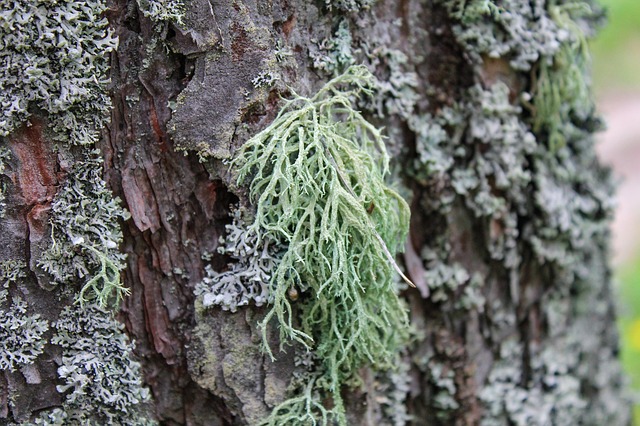Ramalins are a genus of the Ramalin family (Ramalinaceae) of the echinoderm class. There are 11 species in Latvia, the most common of which are the floury ramalina (Ramalina farinacea), the ash ramalina (Ramalina fraxinea) and the even-headed ramalina (Ramalina fastigiata). Ramalinas belong to the shrub lichens. Foliage gray-green to yellow. Sorals and apothecia are often visible on the foliage.
Most often, in Latvia, you will find the floury ramalina on the trunks of various trees. The floury ramalin can tolerate a moderately polluted environment, therefore its distribution is greater. Its foliage is greenish-yellow to gray-green. Rarely, this lichen exceeds 5 cm in size. The branches of the foliage are flat, ribbon-like, on average 3 mm wide. This ramalina has its own peculiarity - sorals are visible along the entire edge of the lobe. They look like floury spots.
One of the most powerful lichens is the ash ramalina, the length of whose foliage tends to grow up to 15 cm and more. It has ribbon-shaped, flattened lobes that are usually up to 4cm wide. Disc-shaped fruiting bodies (apothecia) form on the lobes. This lichen is easy to recognize by its impressive size.
Single-ended ramalina is a small lichen, on average 5 cm high. The foliage is strongly branched, wrinkled and can have both flattened and round lobes. Disc-shaped fruiting bodies (apothecia) form at the tips of the leaf lobes.
Ramalinas, like other lichens, are also of interest to science and their application is sought both by the cosmetic and pharmaceutical industries.
From a chemical point of view, the content of valuable substances in floury ramalin has been determined in the laboratory: mannol, n-octadecanol, eicosene-1, n-tetradecanol, mannol oxide-13-epi, alpha pinene, corvceacin, linalool, etc. Ramalins contain depsides (evernic acid, obtusatic acid, secikainic acid and atranorin), depsidones (prototetraric acid) and dibenzofuran (usnic acid), which also provide the main medicinal properties of this lichen.
One of the most important health-affecting acids in the composition of ramalin is usnic acid, which varies from 0.13-3.23% in different species of ramalin. Among the ramalins, the highest content of uric acid is found in single-ended ramalin (3.23%) and ash ramalin (3.3%), mealy ramilia contains about 0.17% uric acid. Usni acid has an antibiotic effect.
Ramalinas can be collected throughout the year, but it will be more effective under the influence of positive temperatures - in the warm period of the year. Harvesting is done in dry weather. It is good to understand that lichens are very slow-witted, including ramalina. Therefore, it is important to weigh the need and amount of lichen harvesting!
Drying takes place in forced dryers or in a well-ventilated area. The maximum permissible drying temperature is 40C. The resulting mass is stored in a hermetically sealed container for up to 5 years.
From a medicinal point of view, ramalins are used both orally and externally! Ramalins produce anti-inflammatory, antibacterial, antioxidant, fungicidal activity. They are used to fight various bacteria, such as Pseudomonas aeruginosa, Acinetobacter sp., Escherichia coli, and fungi. Also, ramalin is one of the lichens, which contains a sufficient amount of substances that produce a cytostatic effect. Ramalin preparations are also able to act on free radicals, reducing their amount in the body (antioxidant).
Ramalins are also widely used in cosmetics - various "anti-aging" products, shampoos, hair masks and skin care products. They can also be used to make remedies that will help treat the skin from various diseases caused by fungi and bacteria.
Not recommended for use
It should be understood that this article is based on scientific articles and research. It does not always include direct results of research on humans! Accordingly, everyone who has decided to use lichen for health issues must be careful and aware of what is being done and why!
In the more common ramalins, which have also been tested in the laboratory, the presence of poisonous substances has not been detected. And there is information that in ancient times ramalin was also used as one of the nutritional products!
